Scenes from yesterday’s birthday bash!
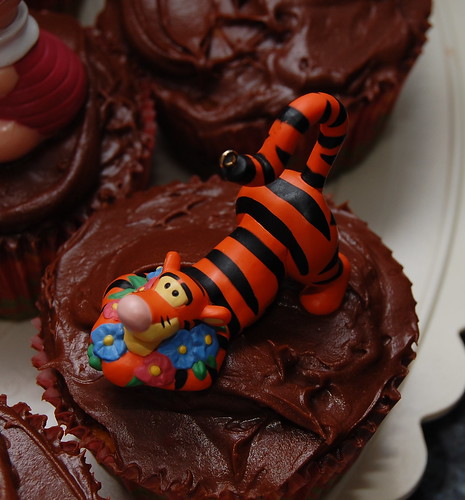
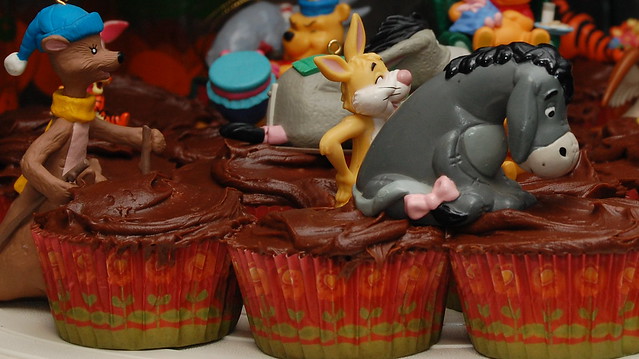


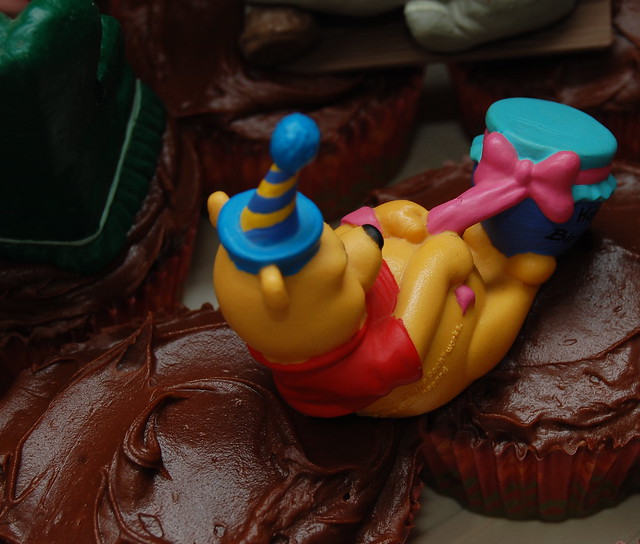
In honor of our late friend Steve’s birthday on April 28. We celebrated his birthdays with him, and now we celebrate for him, and it’s always happy. He would love this. And the chocolate.

An Aries (Who Knows Some Stuff)
Scenes from yesterday’s birthday bash!





In honor of our late friend Steve’s birthday on April 28. We celebrated his birthdays with him, and now we celebrate for him, and it’s always happy. He would love this. And the chocolate.

This week I’ve done a post each in memory of Tim R, John M, Jeff C, and now Steve R. They’re not the only friends and acquaintances Tom and I have lost to AIDS, but these four are the ones who changed our lives.
When I met Steve, he was mourning the loss of his lover–because that’s what he called Don instead of the formal sounding “partner” or clunky “significant other”–in the days before anyone even dreamed “husband” would actually have a legal foundation for same-sex couples in sixteen states (and counting). I never met Don, but I felt like I knew him. When I made an AIDS Memorial Quilt panel for him, I didn’t include his last name, only his initial, out of respect for his family’s privacy. No one in the small rural town where he grew up knew that Don died from complications related to AIDS. His parents had no illusions about who Don was, and they loved him unconditionally. But as his mother explained to Steve, “If the people in our church knew, they would ask us to withdraw our membership there.”
It’s the kind of situation many parents faced–and I suppose still face. The communities from whom they seek the most comfort, because their bonds there are strong, are the ones from whom they keep secrets. (This is not limited to church, but workplaces, social networks, friends and families.) Steve’s parents, who were also from a rural community in a different state, were forthright with their neighbors and fellow worshippers about Steve’s illness and later, his death. People handle things different ways, and I never judged Don’s parents for their decision. I also believe that the several years’ difference between when Don was ill and died and when Steve died were a factor. By the time Steve died in June of 1992, famous people were wearing red ribbons, and the AIDS Memorial Quilt included panels from every state and 28 countries. AIDS was also part of the national political discussion. In October 1992, the entire Quilt was exhibited in Washington, D.C. (Tom and I were volunteers there), and in January 1993, representatives from the NAMES Project were included in President Clinton’s inaugural parade.
After Don died, his mother sent Steve a tasteful set of new bedding–sheets, bedskirt, comforter, shams–because as she said, she worried that sleeping on the sheets where Don had been ill, even though they’d once shared them as a couple, might hurt Steve. She didn’t want him to be lost in grief, but to move forward and find happiness again. I talked to her on the phone several times, and it was clear that her own grief for her lost son was still raw. She felt like she lost another son when Steve died.
We used that bedding for a long time in our guest house, but when Tim made that his home, we packed it away. It’s not the only gift I have from Don’s family to Steve. Once when he was purging things in preparing to move, Steve pulled out a handmade quilt.
“Don’s grandmother made this,” Steve said. “I’d like for someone who would care about it to have it. Do you want it?”
“I’d be honored,” I said.
“Okay, but promise me you won’t let your dogs sleep on it!”
Our dogs Pete and Stevie are long gone, and Margot and Guinness are old girls now. But I never let any of them sleep on Don’s grandmother’s quilt. It’s on the window seat, and they do like to get up there at times, but there are several other quilts on top of it to protect it.
Last night I was thinking about Don, and I wondered… Doesn’t anyone from his hometown ever speculate? Maybe someone has even posted about him online, in a class reunion message board or something. So I googled him, and in doing so, I found his mother’s obituary. She died this past spring–she was eighty-six, outliving her son by twenty-six years.
Steve used to say that when I died, he and Don were going to swing by to pick me up so we could all have a big adventure together in the afterlife. I’d like to think right now, he and Don are making Don’s mother laugh again. She told me once that was a great gift her son possessed.
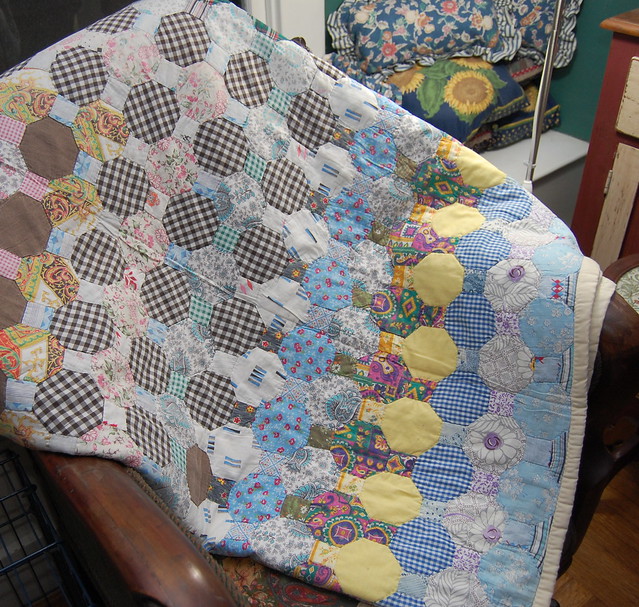
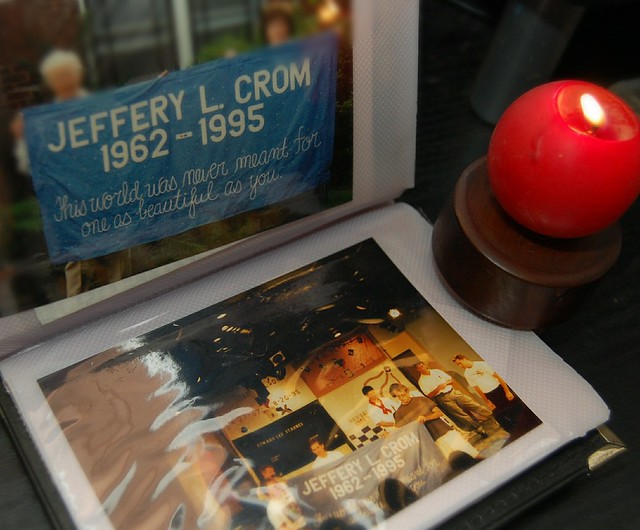
Starry, starry night…
May 11, 1962 — May 4, 1995
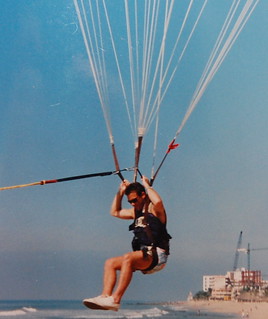
I died from minerality and became vegetable;
And from vegetativeness I died and became animal.
I died from animality and became man.
Then why fear disappearance through death?
Next time I shall die
Bringing forth wings and feathers like angels;
After that, soaring higher than angels–
What you cannot imagine,
I shall be that.
“I Died From Minerality” by Rumi
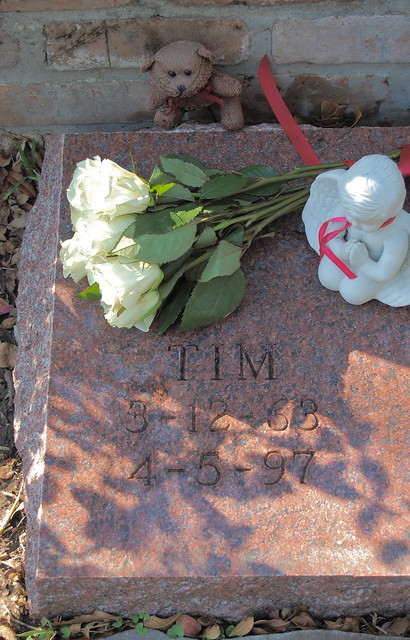
I took only the roses for World AIDS Day. The red-ribboned angel and teddy bear were gifts from others.
 Monday I went to Thomas Street Health Center, a clinic that’s been serving the HIV/AIDS community in Houston since 1989.
Monday I went to Thomas Street Health Center, a clinic that’s been serving the HIV/AIDS community in Houston since 1989.
I’d read that the center was exhibiting works from their “Healing Art for the Heart” project. As described in the photo on the left, this art therapy project is meant to “help HIV-positive (+) patients channel their emotions and provide a therapeutic outlet.” Many of the paintings on display are the patients’ creative ways of illustrating their journeys with HIV/AIDS. I wanted to feature a few of them. You can click on any of the photos to see larger versions.
If you aren’t able to read the accompanying descriptions and are interested in one or more, let me know in comments, and I’ll type them out.
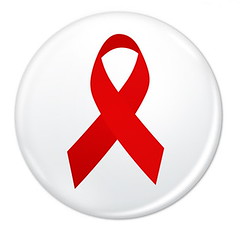
Today marks the twenty-fifth year of recognizing December 1 as World AIDS Day. The 2013 theme is “Shared Responsibility: Strengthening Results for an AIDS-Free Generation.”
You can read more about World AIDS Day and ways you can promote awareness of and help eradicate HIV/AIDS here.
A list of events in Houston commemorating World AIDS Day 2013 is here.

An old shadowbox I created using mementos from a friendship.
Prompt from FMS Photo A Day.
Yesterday when I went out to take a package from the UPS driver at the gate, I noticed a small bird on the ground and didn’t think much of it. But later, when I went out with the dogs, they thought a LOT of it. Their interest was in making it a morning snack, and I realized that the bird couldn’t get away from them. I shooed the dogs back inside and had a look around. That’s when I spotted a nest that had fallen from a tree and broken up, and now its occupant, too young to fly, was helpless against Compound dogs and also this guy who was wandering around.
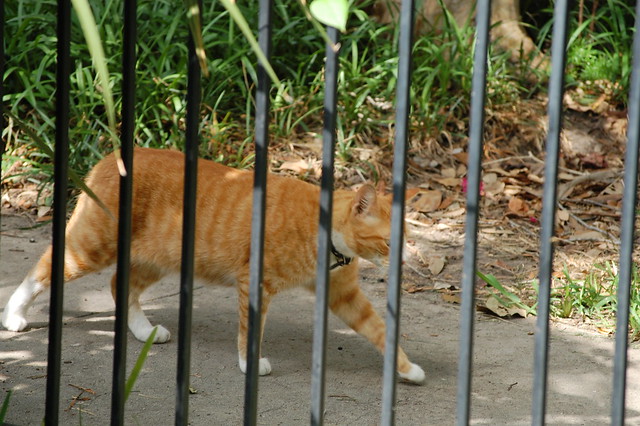
We have so many doves living on or around The Compound, and I figured this one was a mourning dove. Much to his dismay, I used a small stick from his nest to direct him into a box, where’d I’d placed the part of the nest I could salvage. I was keeping a wary eye skyward, as I didn’t want an irate parent to swoop down on me, but when she finally arrived, she stayed on the ground, getting as close to me as she dared, to watch what I was doing with her young’un.
What I really wanted was to return the nest to the tree–a nice leafy, tall ornamental in our front flower bed (planted as a tiny thing by James many years ago, we call it “John’s tree” in his late boyfriend’s memory), but the good branches are too high for me to reach, even by ladder. I finally took this from the backyard, where it’s been hanging with a dead plant forever, and transferred nest and reluctant baby into it.


Once the new home was hanging in the tree, the baby bird clung to the wire edges instead of getting into the nest. Mama landed a couple of times, pecking at the nest and apparently soothing her child. Later, Tim moved it higher so the birds wouldn’t be so exposed while hanging from the lower branches. A couple of times I checked on them by looking through windows. I was watching when the dad showed up. Mama flew over the sticks on the ground, as if saying, “See? I told you we shouldn’t have scrimped on building supplies and hired that cheap contractor.”
Tim and I left to run errands, and by the time we returned, Mama had coaxed baby down into the nest, and they were both resting (though she’s not in this photo).
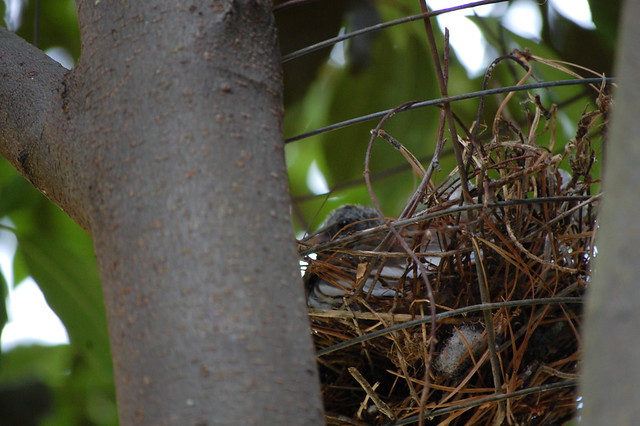
Late afternoon, I checked on them again. No parents were around, and baby was still in the nest, but now I realized that the afternoon sun was baking him.
Fortunately, Tom came home not long after and using the ladder, was able to find a great place for the hanging nest where leaves would shade it from the sun at any angle.
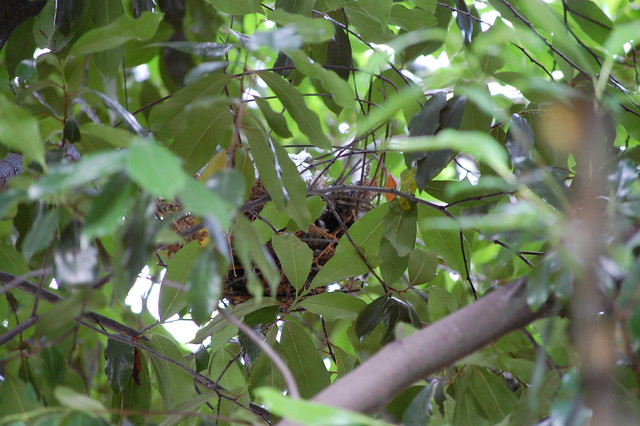
This whole procedure was watched from high in our redbud tree by both parents.
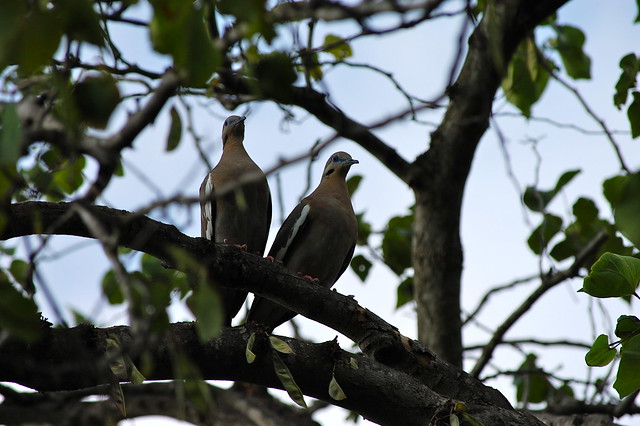
Just before dark, Tom checked on them again, and mother and child were both sleeping inside the new home.
This morning, I went outside to see how things were. I spotted Mama on the branch next to the nest.
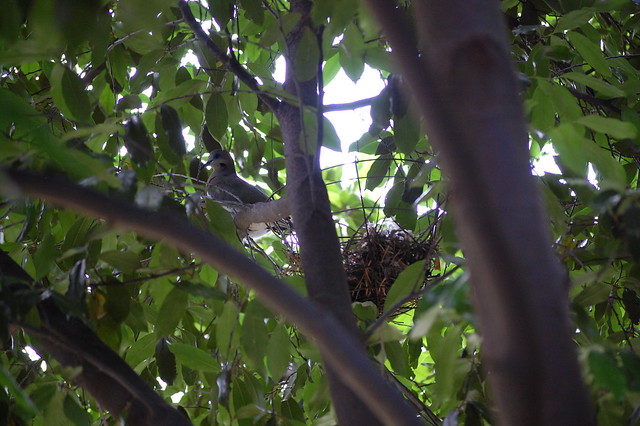
Then, when I walked beneath it, guess who I spied enjoying the day, as if none of yesterday’s trauma ever happened?
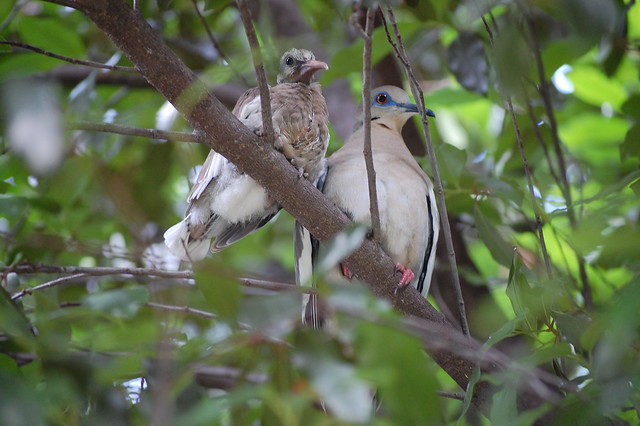
I think the Muse of Stevie Nicks will bring good luck to me because as it turns out, this is a family of white-winged doves.
There wasn’t a single panel I attended at Saints and Sinners that didn’t give me a lot to think about, and this was my first on Saturday morning: AIDS Is Still With Us: Telling An Essential Story.
Moderated by Jameson Currier (Where the Rainbow Ends; The Wolf at The Door; Dancing on the Moon), the panelists were Lewis DeSimone (Chemistry; The Heart’s History), Trebor Healey (Through It Came Bright Colors; A Horse Named Sorrow; Faun; Sweet Son of Pan), Daniel M. Jaffe (Jewish Gentle and Other Stories of Gay-Jewish Living; The Limits of Pleasure; One-Foot Lover), and Andrew Holleran (Dancer from the Dance; Nights in Aruba; The Beauty of Men; Grief).

In the early and mid 1990s, the years when I was an AIDS caregiver to several friends, many of the above books and others were essential in helping me understand the politics and social and personal implications of AIDS, particularly as it affected gay men. In fact, sometimes their voices and the stories they told helped me keep my wits in a world gone mad. Fiction and memoir also gave my friends and me a place to begin sharing a language and context with one another. Those books broke down barriers and gave faces and names to what to many people were just statistics that they believed had no impact on their lives.
I remember after Steve R died how I attempted to write several different short stories, and I believe even the beginnings of a novel or two, but I simply couldn’t do it. Everything was too raw, too close. But I think all of those stories–from the caregivers, the ill, the healthy positive, the partners and friends–both old and current, still need to be told. I think there’s public complacency, a sense that because new drugs and treatments have made HIV manageable, that no one wants to read about it anymore. But the compelling stories of populations with rising numbers of HIV infections and AIDS illnesses still have something to tell us about poverty, marginalization, medical care and drug access, and health crises–because AIDS/HIV surely won’t be the last.
I’m grateful these writers and others are still telling the stories. They encourage me to feel that my own voice might join the conversation one day.